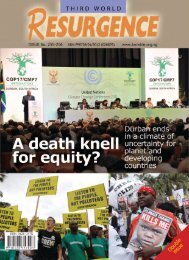Plantations, poverty and power - Critical Information Collective
Plantations, poverty and power - Critical Information Collective
Plantations, poverty and power - Critical Information Collective
Create successful ePaper yourself
Turn your PDF publications into a flip-book with our unique Google optimized e-Paper software.
59<br />
logging. While the investigation is long overdue, APP simply exp<strong>and</strong>ed its logging operations in Jambi<br />
province, cutting 50,000 hectares of Bukit Tigapuluh Forest. WWF Indonesia notes that “some of the<br />
clearing seems to be in violation of Indonesian law”. Part of the area cleared is a proposed Specific<br />
Protected Area. The forest is habitat to Sumatran orangutans, tigers <strong>and</strong> elephants. The forest is also home<br />
to two tribes of Indigenous Peoples, one of which is found nowhere else in Sumatra. APP has plans to<br />
build a new road through the Bukit Tigapuluh Forest, to facilitate transport of timber to its pulp mills. 293<br />
Pollution <strong>and</strong> pulp production<br />
As well as destroying forests, APP has polluted the Siak River. Indah Kiat started its first pulp mill at<br />
Perawang in 1984, with an outdated factory imported from Taiwan. The 100,000 tonnes a year pulp mill<br />
used elemental chlorine <strong>and</strong> wastes were discharged into the Siak River. Protests from local villagers led<br />
to an agreement in 1992, mediated by Indonesia’s Environmental Impact Management Agency,<br />
BAPEDAL, under which Indah Kiat agreed to meet the villagers’ dem<strong>and</strong>s. The company, however,<br />
failed to do so. Indah Kiat’s pulp <strong>and</strong> paper mills have exp<strong>and</strong>ed to cover an area of 400 hectares <strong>and</strong> now<br />
use a mixture of chlorine <strong>and</strong> elemental chlorine free bleaching. 294<br />
Six years ago, German film-maker Inge Altermeier visited Indah Kiat to produce a film about the impacts<br />
of pulp production on local communities. She found <strong>and</strong> filmed an illegal outlet from Indah Kiat’s mill,<br />
which the company used at night. During the day the output was not in use, but the air stank <strong>and</strong> dead fish<br />
floated in the river.<br />
In a village near Indah Kiat’s mill, people complained about the bad smell <strong>and</strong> told the film-maker that<br />
they were suffering from itching, headaches <strong>and</strong> vomiting. A villager called Tasjudin showed Altemeier<br />
his garden. Since Indah Kiat arrived, there are no more coconuts on his trees. The fruit on his trees is<br />
covered in black spots <strong>and</strong> it rots before it ripens. “Indah Kiat is ruining our lives. But what am I to do<br />
This is my home, I have to live here,” Tasjudin said.<br />
Before Indah Kiat built its pulp mill, people could fish in the Siak River. They used the river for drinking<br />
water <strong>and</strong> for bathing in. Since villagers can no longer drink from the river, they dem<strong>and</strong>ed that Indah<br />
Kiat provide them with clean water. The company gave them a water pump. But villagers found that the<br />
ground water was also polluted <strong>and</strong> smelled bad. Villagers are forced to buy bottled water to drink. Many<br />
still wash in the river because there is not enough pumped water especially in the dry season. 295<br />
In 2005, Rully Syum<strong>and</strong>a, Forest Campaigner with WALHI, <strong>and</strong> Rivani Noor, from the Community<br />
Alliance for Pulp Paper Advocacy, interviewed people in villages near to Indah Kiat’s mill in Perawang.<br />
They also spoke to people living in Perawang. Villagers told them their vegetables, chillies <strong>and</strong> flowers<br />
did not grow normally, especially in the dry season. During the rainy season, a many of the villagers’<br />
hens <strong>and</strong> ducks die. They told the researchers they were sure that the cause was the smoke containing<br />
harmful chemicals from Indah Kiat’s mill.<br />
293 “Highway Planned by Paper Giant Asian Pulp <strong>and</strong> Paper Will Destroy Sumatran Forests, says WWF”, Press Release,<br />
7 January 2008. http://www.worldwildlife.org/who/media/press/2008/WWFPresitem4905.html<br />
294 Mats Valentin <strong>and</strong> Kristina Bjurling (2004) “Swedish involvement in the Indonesian paper <strong>and</strong> pulp industry”,<br />
SwedWatch, October 2004.<br />
295 Chris Lang (2005) “Indonesia: The health impacts of living near Indah Kiat’s pulp <strong>and</strong> paper mills”, World<br />
Rainforest Movement Bulletin 97, August 2005. http://chrislang.org/2005/08/27/indonesia-the-health-impacts-of-livingnear-indah-kiats-pulp-<strong>and</strong>-paper-mills/















